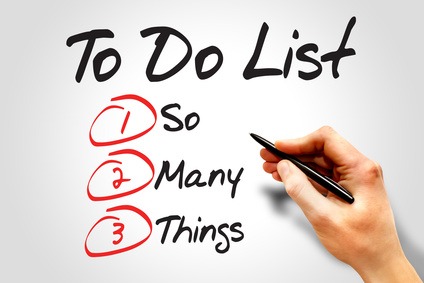
by Lori Vande Krol | Feb 17, 2020 | Task and Project Management, Team Productivity, Technology
Unless you completely avoid politics and social media, you have no doubt heard about the “caucus chaos” that recently occurred right outside my door in Iowa. Much of the media has blamed the chaos on a new smartphone app the Iowa Democratic Party implemented to help get results more quickly. Because I have a large interest in the successful selection and implementation of technology, I thought I’d dig into it a bit further. What happened in Iowa is just one very publicized example of what happens daily in companies and organizations that do not take the time to properly analyze their vision and needs when choosing a new technology tool, or to carefully plan for a successful implementation of the chosen system. How could this have been avoided?
What Went Wrong with the Iowa Caucus?
It is true that much of the cause for reporting delays and questions about count accuracy was due to a “coding error” in the Shadow smartphone application that was used by the Iowa Democratic Party (IDP) to report caucus voting results. The error resulted in only partial results being reported. But if you look just a little deeper, there were more underlying issues that can’t be blamed solely on the creator of the application.
Following are additional factors leading to the issues with the Iowa Caucus:
- State campaign finance records show the IDP paid Shadow, the tech company that created the app used in Iowa, more than $60,000 for “website development” towards the end of 2019. Shadow (or what I’ve also seen called the Iowa Reporter App) was a new app, reported to be just 5 months old, and created specifically for reporting of caucus results. This is not enough time to have been developed and fully tested before being rolled out for such a large and public endeavor.
- Once the IDP had the app, there was not enough time for users to learn and test it themselves. In fact, some users weren’t even able to get past the log-in screen.
- This year, a new set of reporting requirements was put in place by the Democratic National Committee. Historically, precincts would only announce the outcome in terms of state delegate equivalents (S.D.E.s). In 2020, precincts were required to report three numbers per candidate: (1) raw vote totals, (the initial alignment), (2) the totals after the shifts of participants from non-viable candidates (the second alignment) and (3) the estimated delegate count for each candidate. While this may be confusing for those not involved with caucus procedure, it isn’t difficult to reason that this increase in requirements, along with the use of a new application, and short time frame for development, training and testing, was the start of “the perfect storm.”
- In addition to the Shadow app, it was reported that there were training issues with other programs needed for efficient reporting of results, including Google Sheets, and problems with 2-factor authorization needed to access those programs.
- The back-up process for reporting results when the app did not work was to call headquarters and manually report results (which is the way it had been done in past years). But, there were not enough lines and/or people to answer these calls and volunteers were left waiting for hours. It was quite obvious the back-up plan hadn’t been fully thought through.
It is my guess that there were more issues involved in the selection and implementation of caucus reporting systems and processes this year. Iowa Democratic Party Chairman, Troy Price, has called for an independent forensic review of the decisions and processes (or lack of processes) that led to the failure. I look forward to learning more from that review.
2020 Iowa Caucus Consequences
What we do know is that there has been some pretty large consequences of the lack of proper analysis, testing, and implementation.
- Chairman Price has resigned as chair of the party after 2.5 years of service, effective as soon as a replacement is elected.
- The Nevada Democratic Party, who had planned to use Shadow, has now dropped the vendor.
- The Democratic National Committee Chair, Tom Perez, along with the Bernie Sanders campaign, have asked for a “recanvassing” check of votes.
- Thousands of extra volunteer and paid hours were needed to report the initial results and will be needed to assist with the recanvassing as well as the independent forensic review.
- The negative PR for the Iowa Democratic Party and the state of Iowa will likely result in Iowa losing its status as the first caucus state in the country, with a large impact to hotels, restaurants and other local vendors that benefited from the event. It is not unreasonable to assume this misstep has costed the IDP and the State of Iowa hundreds of thousands of dollars.
How the Caucus Chaos Could Have Been Prevented

The chaos that occurred in Iowa could have been fairly easily prevented. Following are the key components of successful technology assessment and implementation, and what may have been missing from the Iowa Caucus process:
Understand Your Need and Create a Vision for Success
What is driving the desire or need for the new system or tool? Are you solving an issue, creating efficiencies, or enhancing a process in another way? What will success look like? What will you be able to do that you cannot do now?
What was missing? While we won’t know for sure until after the independent review, I have to wonder if the IDP did what I see many other companies do…they go for the newest shiny object without truly analyzing the need and how the tool might fulfill it. Was it necessary to change the current system for caucus counting and reporting? What was the specific issue that needed to be addressed? If there was a challenge in the current process, or the IDP wanted to save time and create efficiencies by using an automated app, was a vision defined? How did they see a new tool working and what would success look like? They could then choose a tool to best fit that vision for success. Perhaps the IDP did spend some time on this component and was clear in their need and vision but faltered in a later step.
Implement a Needs Analysis
A formal Needs Analysis takes the component above – understanding need and vision – several steps further in that it provides a process for decision makers to gather information needed to select the optimal technology. The Needs Analysis will address:
- resources available and new resources needed to implement and maintain the tool, including human and financial resources, and timeline;
- any obstacles that could get in the way of implementation or maintenance of the tools;
- level of comfort with technology, leading to a better understanding of training needs;
- features needed, which can be gathered in a format such as “must have”, “nice to have”, and “not needed.”
What was missing? Did the IDP take the time to evaluate all of these steps prior to asking Shadow to develop the app for them? They may have been clear on their budget and the needed features, but it is clear that not enough time was spent discussing obstacles that could prevent effective implementation (such as the app not working when it is needed most!), training needs due to many users not having a high level of comfort with technology, and the impact of an unreasonable timeline for development, testing, and training. This could have all been addressed with an appropriate Needs Analysis.
Match the Need with the Technology
Once the Needs Analysis has been completed, it becomes much easier to match the appropriate technology tool with the need. There are many great resources to find and evaluate applications but what is most important is to find the tool that best matches the results of the Needs Analysis and to evaluate the strength, security, and longevity of the application’s creator and/or owner.
What was missing? Without the appropriate Needs Analysis, it was impossible for the IDP to know whether they were choosing the most optimal system. Based on a February 4, 2020 article from The Atlantic, there is evidence that this was a situation in which leaders in the IDP knew some of the leaders in Shadow’s company and that appeared to be enough to move forward with their application.
Develop the Project Plan
Once the optimal technology is chosen, it is time to develop a plan for successful implementation. There is too much involved with project planning to cover here (refer to Get Unstuck With a Simple Project Plan for project planning tips), but the importance of creating and following a technology implementation plan cannot be stressed enough.
What was missing? What wasn’t missing? I believe that due to the tight time frame involved, the IDP had no time to develop or carry out a successful project plan. Just a few of the pieces missing were: (1) time for testing the application, (2) training of all users, and (3) creation of backup plans for multiple situations.
Take a Holistic View of Technology
A holistic view of technology means looking at all of the systems currently used by an organization and determining how new technology will coordinate and compliment those systems. This is important for an efficient implementation of the new technology as well as continued effective use and maintenance.
What was missing? While I am not aware of all of the systems utilized by the IDP, one main obstacle that was not addressed was how to coordinate the use of the new application with those precincts that desired or needed to continue to use the old, manual method of reporting. It has been reported that the IDP assumed all volunteers would download the app with no issues, even though some did not receive instructions to do so until 2 days before the caucus. Staffing and technology needed to take the manual calls was not sufficient. Additionally, there was the issue with 2-factor authorization that was discussed earlier. Cell phones were not allowed in counting rooms, but 2-factor authorization within the technology required volunteers to have their cell phones to receive the security code. Understanding how the technology would need to coordinate with the use of cell phones was vital here.
What Have We Learned from the Iowa Caucus Chaos?
While the Iowa Caucus gaffe was certainly unfortunate and impactful, how many can say they have never been involved with an organization that has not made a similar mistake – rushing through decisions, not completing a thorough needs analysis, or not developing and following a project plan? In my work as a productivity consultant, I often find during new client discovery sessions that some of their productivity challenges are caused by the mistakes made in technology selection and/or implementation. Organizations ranging from Fortune 500 corporations to very small businesses struggle every day with the results of poor planning and decision-making resulting in thousands of hours and millions of dollars lost and frustrated management and employees. Additional time and money are then spent to clean up the mess and redo the process the right way.
Hopefully some good can come from the Iowa Democratic Party’s mistake, that is a larger awareness of the importance of following the steps for successful technology implementation. While it will take more time and effort upfront, we have learned that the consequences of not doing so can be much greater.

by Lori Vande Krol | Sep 24, 2019 | Goals and Priorities, Procrastination, Task and Project Management, Team Productivity, Time Management
Have you ever read a book that changed your life? At the recommendation of several friends in the business world, I recently completed Building a Story Brand by Donald Miller. Donald promises that after reading his book you will be able to “use the 7 elements of great storytelling to grow your business.” Before reading Building a Story Brand, I had never been excited about marketing. It does not come naturally to me, I am not good at it, and it is not fun for me….at least these have been my excuses for when I don’t put in the time and effort needed as a business owner.
The content of Building a Story Brand really struck a chord with me and provided me with a way to view “marketing” like I haven’t before, but this isn’t a book review. The truly eye-opening result of the book was that I was reminded of the importance of two things for any successful endeavor:
- A clear vision that resonates and
- a simple project plan.
While I had hired marketing experts in the past to assist me with specific pieces of my branding and marketing, I did not have an overriding plan that resonated with me. This book provided that for me. For someone who helps clients clarify their goals and develop customized productivity plans for a living, I’m embarrassed to admit it took this long to realize what I was missing!
Building a Plan for Productivity
What have you been procrastinating, or avoiding, in work or life? What projects have been slow-moving or “stuck” within your office or business? What reasons have you, or your team, used for not taking action? Could it be that you also need a clear, concise plan that resonates? Project plans not only provide the step-by-step tasks needed to reach your goals but can also help you “get unstuck” and motivate you and your team. (For more tips on tackling procrastination, check out “Reduce Procrastination with 3 Powerful Steps”.)
Parts of a Successful Project Plan
When creating or revising a plan, be sure to include the following important aspects:
Create a Vision for Success
What will the final result look like? How will success feel? What will you be able to do that you can’t do now? What drives you and your team towards this vision?
Determine Your Goals and Actions
Define the high-level goals that are needed to reach your end vision and put specific action steps behind them. Don’t make it too difficult at first – you can fine tune as you go.
Evaluate Your Resources
What human, technology, budgetary and other resources are needed to reach your goals? What do you have now and what additional resources are needed?
Schedule Your Actions
Once you have your actions and resources defined, you can determine a schedule for completion. Consider choosing an end-date and working backwards. Or, choose intermediate deadlines for the high-level goals and then schedule your action steps to meet those dates.
Celebrate and Maintain Your Success
Celebration is a great bridge between project completion and maintenance. You will also need to determine how you will maintain your success.
Consider Your Risks and Obstacles
For most projects or goals, it’s also important to consider and discuss any risks and obstacles you might encounter along the way and how they’ll be addressed.
Just Get Started
 The most important thing is to get started, or “just do it” as Nike® would say. If you don’t have a complete, detailed vision or if you aren’t yet sure of the resources needed for each goal or task, that’s okay. You can start with a good framework and add to it – or even change direction if needed – as you go. Start small to gain momentum. Don’t waste another day before tackling that project, writing your book, or getting healthier. Whatever your end goal, just jot down your vision, goals and tasks and take action!
The most important thing is to get started, or “just do it” as Nike® would say. If you don’t have a complete, detailed vision or if you aren’t yet sure of the resources needed for each goal or task, that’s okay. You can start with a good framework and add to it – or even change direction if needed – as you go. Start small to gain momentum. Don’t waste another day before tackling that project, writing your book, or getting healthier. Whatever your end goal, just jot down your vision, goals and tasks and take action!
P.S. If plan development isn’t your thing, I’d love to help. I’ll listen to your needs, help you fine-tune your vision and goals, and document the action steps needed to reach your vision. I can also remain by your side to provide support and accountability as you walk through your customized plan. Schedule your free 30 minute productivity assessment to see if productivity coaching is right for you.

by Lori Vande Krol | Jun 24, 2019 | Goals and Priorities, Task and Project Management, Time Management
One of the most successful exercises I have done related to time management is to create two written lists which help me focus, set priorities and ensure I am working on the right things. The first list states “10 Things I Want to Be Doing That I am Not Currently Doing” and the second list states “10 Things I am Doing that I Would Rather Not Be “.
The lists cover not only career related items, but personal items as well – anything that I feel will bring the appropriate balance, direction and focus to my life. Just the act of forcing myself to think through these lists, and write them down, taught me more about myself and my priorities then any prior exercise.
Gain Focus and Accountability
I then shared my lists with an accountability partner, who did the same. We talked through our lists and discussed how we might change our current situation to address the items on the lists. We then chose an item from each of our individual lists that we felt were not only high priority, but that could reasonably be achieved in the time we set for ourselves.
We continued to speak on a scheduled basis. We discussed our progress and when we were ready, choose another item from our lists to focus on until we spoke again. Forcing myself to write down BOTH lists gave me more focus and direction than I’d had in a long time. Knowing that I had a partner that was interested in my actions and goals kept me motivated. If I felt myself distracted or not sure what I should be working on, I could go back to my lists and conversation notes and once again become focused on what is most important.
Try It
Why not take 15 minutes and try this exercise for yourself. Create your two lists and find a partner to keep you focused and hold you accountable. I’m confident your productivity will increase as well. Let me know how it goes by coming back and commenting below.
Need an accountability partner? Shoot me an email at lori@alifemadesimple.com to learn more about how Productivity Coaching can help you overcome overwhelm, get clear, and reach your goals.

by Lori Vande Krol | Mar 15, 2019 | Delegation, Organization, Procrastination, Time Management
Clutter is delayed decisions – whether it be paper clutter, email clutter, mind clutter or any other type of clutter in your home or office. Piles start because you are postponing making a decision on an item…then another… then another… So how can we simplify the choices that we need to make each day?
Following are 5 tips to help simplify your decision-making and reduce your piles.
Delegate
What could be better done, or used, by someone else? Choose those things that you love to do or love to look at and find someone else to take care of the rest. If you need help determining what to handle yourself and what to delegate, or donate, don’t be afraid to call in a professional or an unbiased friend to assist.
Gain Perspective
Try to step back and see yourself as others see you in your situation. This can serve as a reality check and open your eyes to things you have been avoiding. If you are having trouble with this exercise, find someone you trust and ask for his or her opinion — but be ready for the answers and keep an open mind.
Use a Timer
When a task seems overwhelming, or when you find yourself spending all day researching a decision on the internet or clearing out your email inbox, a timer is a wonderful tool. Set it for 10 minutes, 30 minutes or 1 hour depending on the task. Work diligently during this time to make the appropriate decision(s). The task will seem less overwhelming and take much less energy.
Have a System
Having the appropriate systems and tools in place is very important in simplifying your decision-making. For example, the ART System™ works wonderfully for addressing your paper and electronic “piles.” Every item should either be acted on (or delegated to someone else to act upon), filed away for future reference, or tossed. With effective tools in place that work for your needs and personality, these decisions become much simpler.
Let Go of Perfectionism
You might be surprised at how many of my clients are perfectionists. They say they are cluttered and disorganized because if something can’t be perfect, they don’t want to do it at all. Sound familiar? As a recovering perfectionist myself, I completely understand this feeling. But sometimes you need to determine that ‘good is good enough’ and move on. One way I have found to address this issue within my home is to hire a cleaning lady (see #1 – Delegate). If I clean my own home, I would spend far too much time on the picky details, while she is not only much more efficient at cleaning my home, but she knows when good is good enough.
Another tip for addressing perfectionism is to repeat to yourself a phrase I learned from a mentor, Barbara Hemphill. Barbara often says “Doing something is better than doing nothing at all.” If I didn’t believe and live by this phrase every day, you might not be reading this article right now. Is it perfect? No. Is it good enough. I hope so.

by Lori Vande Krol | Dec 15, 2018 | Time Management
Being late is rarely about just being late. Oftentimes, it’s related to fear of downtime and/or a lack of time management skills. We’re all given the same 24 hours in a day. Yet some of us have that polished capacity to arrive with enough time before morning meetings to brew a fresh coffee. While others’ scrambled entrance is flustered and chaotic.
Not that tardiness is always negative. In fact, according to Quartz, there’s an upside to being that person who’s always late: It means you’re incredibly optimistic. But wouldn’t it be considerably less stressful to see the glass half full while arriving on time? According to these five time-management tips from MakeSpace (a convenient alternative to self-storage units in Chicago, NYC, LA, and Washington, DC), it’s possible:
1. Plan your week before you’re in it
It’s all too often that we find ourselves at 2 PM on a Thursday, rushing to meet deadlines that seemed eons away on Monday morning. It’s this last-minute, “must-get-done-now” feeling that often leaks into our personal lives, and causes us to be late to other places. Combat that pressure by planning out your week on a Sunday night or Monday morning. Use a “brain-dump” to determine your high priorities, then figure out where they’ll fit into your calendar. This will make it easier to check off your weekly assignments, leaving space for any last-minute tasks that pop up. Which brings us to the second tip …
2. Prioritize and schedule your most important tasks
The problem: You have a million things that came up last minute, all of which you know you need to complete by tomorrow. You also have a dinner party after work that your significant other begged you not to be late for (again).
 The solution: Take advantage of some free time in the evening before, and jot down a to-do list.
The solution: Take advantage of some free time in the evening before, and jot down a to-do list.
Sounds like a no brainer, right? But here’s the kicker:
Give each task on that to-do list a sub-deadline. Break down each big, important task (your “Most Important Tasks,” or M.I.T.) into smaller, more manageable tasks. Then, give those smaller tasks a time limit. HubSpot uses the typical M.I.T. example of creating a slideshow presentation. Breaking it down into sub-deadlines would look like this:
“9:00 – 10:00 am: outline the presentation
10:00 – 11:30 am: write copy for the presentation
11:30 – 12:30 pm: create all images for the presentation
12:30 pm: lunch w/ Jack”
Keep your sub-deadline schedule nearby, or in a web-based app like 42goals. Or set a timer for each task to keep you alert and attentive. Studies have shown the Pomodoro technique to be highly effective for this. It works like this:
- Work for 25 minutes, known as one “pomodoro.” Rest for five minutes. After you finish four pomodori, take a longer break to recharge.
- You can alter the time according to your own personal attention span. Test the technique out on yourself with Moosti.
These small but powerful swaps will hold you accountable to yourself, and keep your personal timing in check.
3. Hope for the best — but expect the worst
Remember what we said about the overlap between optimism and chronic tardiness? Here’s where it’s helpful to keep that idealism in check: Elite Daily notes that people who are optimistic are often late because they believe they can do more things with the time they have.
Let’s say Tom Tardy has 45 minutes for his 40-minute commute. As an optimist, he truly believes those extra five minutes can be used to pop into his favorite coffee shop. And while we don’t want to rain on Tom’s parade – there’s plenty of upsides to being an optimist, like a significantly high health score – there are some tweaks he can make to be more attentive. He could take into account that the coffee shop might have a longer line than usual, for example. Or that traffic is heavy today. Or that he’s running low on gas. And given that he’s on a time crunch, Tom would be better off without trying to squeeze any extra tasks in. By leaving early enough to “plan for trouble,” Tom staves off any potential issues that could stand in between him and arriving on time.
 4. Embrace a daily routine
4. Embrace a daily routine
What do Anna Wintor, Oprah, and the German public transportation system have in common? They all have a routine they stick to, which allows them to always be on time. Getting into the swing of a routine that works for your lifestyle will allow for structure that fosters punctuality.
5. Try these four life hacks for an extra productivity boost
If all else fails and you’re still struggling to arrive on time, try some of these simple hacks:
- Clutter hurts your productivity. So, declutter your entryway. Then designate a spot by the door to hold all your daily must-haves like keys, your wallet, a backup umbrella, and reading materials for the commute. You can grab stuff without wasting any time searching, or making sure you have everything. That extra 30 seconds could be the difference between missing and making your train.
- Set all your clocks ahead by different times. It’s the age-old procrastinator trick, with a twist. Set your oven’s clock five minutes ahead, your microwave three, your living room clock seven, etc. You’ll trick yourself into leaving on time, since you won’t be certain which clock actually has the right time.
- Use a special alarm so you never miss a morning meeting again. You can use an alarm that tracks your sleep and wakes you up when you’re in your sleep cycle’s prime. Or use “the world’s most annoying alarm app” that won’t stop ringing until you’ve taken a photo … outside of your bedroom.
- Schedule built-in overflow time. Just as you should give yourself plenty of time to arrive somewhere, schedule plenty of time on your calendar for tasks. This simple tweak just might be your superpower secret to solving any mid-morning crises that threaten to overtake your day. Like your monthly expense report that was due yesterday.
Life Made Simple would like to thank MakeSpace for this excellent guest blog post. I will definitely be taking some of these tips to heart! Check out the MakeSpace website for a simple and innovative way to move and store your furniture and other items.

by Lori Vande Krol | Oct 15, 2018 | Meetings, Time Management
A recent survey by management software developer AtTask and market research firm Harris Interactive asked 2000 office workers how they spend their time each day. Results showed that 7% of our time at work is spent in wasteful meetings. In fact, 45% of those surveyed feel time spent in wasteful meetings is the largest contributor to lost productivity. Meetings are necessary for communication and collaboration, but how do we ensure that the time spent is not wasted?
Before the Meeting: Never schedule a meeting without a thoughtful agenda. In fact, businesses and teams should have an agenda template that is used for all meetings. The template should obviously include logistics like date, start and end time, and location. The agenda should also assign a meeting leader and list others invited. Attendees should include only those that will benefit from or provide value to the meeting. The agenda should state an objective for the meeting to ensure the meeting has a clear purpose and expected outcome.
Finally, the agenda should list the topics for presentation, review, and/or discussion. Times for each meeting topic should also be determined and shared to allow attendees to prepare based on the amount of time devoted to each. If an attendee needs more time for a certain topic, this can be adjusted prior to the meeting. @JamiePrip suggests limiting the number of items on your agenda to big-picture topics for the organization. In addition, he warns meetings that are open-ended tend to go longer than they need to.
Agenda templates can be built in a document program such as Microsoft Word, in your email/calendar program, or use a pre-built agenda in an application such as Do for Apple products or cloud-based tools Worklife and Minute. Agendas should be shared with meeting attendees several days prior to the meeting to allow for sufficient preparation (jamieprip.com).
During the Meeting: The meeting leader’s responsibilities are to ensure the meeting starts and ends on time and to keep the meeting on track. If a topic is going longer than planned, table it for a future meeting in order to get through your agenda on time. If a topic is going off-track, pull it back to focus. A timer, such as The Time Timer, can provide a visual reminder. Have someone assigned to take notes during the meeting, including top points of resolution or non-resolution and any future action items. The applications mentioned above (Do, Worklife and Minute) include features to assign and track tasks resulting from the meeting. Before adjourning, summarize results and next steps. Time for this should be built into the agenda.
As an attendee, you may also take notes during the meeting. These notes are likely more personal to your responsibilities and actions. Circle, highlight, or star actionable items so that they are easy to pull from your notes after the meeting.
After the Meeting: Meeting notes and next actions should be stored in a central location and shared with attendees and others as appropriate. Any “next steps” should be clear and include target dates and names. Individual tasks from the full meeting notes, as well as any highlighted in personal notes, should immediately be added to your project and/or task management system.
In summary, there are 5 key steps to an effective meeting:
1. Have a Clear Objective
2. Create a Thoughtful Agenda
3. Assign a Meeting Leader
4. Assign a Note Taker / Task Manager
5. Summarize Results and Next Steps
If you are missing even one of these steps, your meeting can quickly turn from productive to wasteful.




 The most important thing is to get started, or “just do it” as Nike® would say. If you don’t have a complete, detailed vision or if you aren’t yet sure of the resources needed for each goal or task, that’s okay. You can start with a good framework and add to it – or even change direction if needed – as you go.
The most important thing is to get started, or “just do it” as Nike® would say. If you don’t have a complete, detailed vision or if you aren’t yet sure of the resources needed for each goal or task, that’s okay. You can start with a good framework and add to it – or even change direction if needed – as you go. 


 The solution: Take advantage of some free time in the evening before, and jot down a to-do list.
The solution: Take advantage of some free time in the evening before, and jot down a to-do list. 4. Embrace a daily routine
4. Embrace a daily routine
Recent Comments